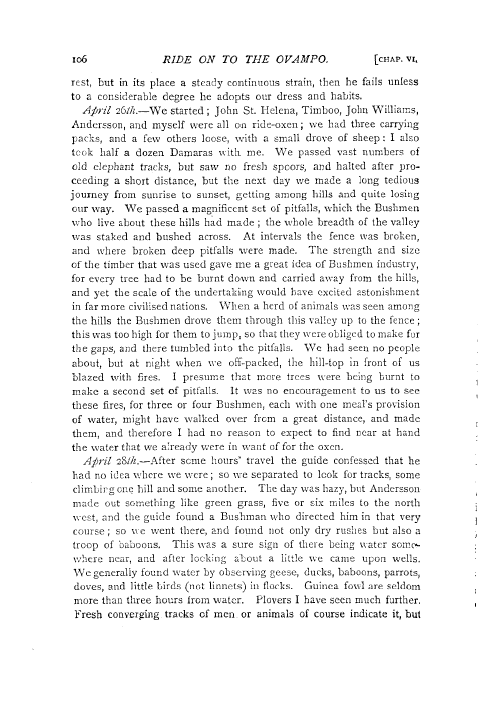io6 RIDE ON TO THE OVAMPO, [CHAP. vr,
rest, but in its place a steady continuous strain, then he fails unless to a considerable degree he adopts our dress and habits.
Aril 261/1.-We started ; John St. Ilelena, Timboo, John Williams, Andersson, and myself were all on ride-oxen ; we had three carrying packs, and a few others Loose, with a small drove of sheep: I also took half a dozen Damaras with me. We passed vast numbers of old elephant tracks, but saw no fresh spoors, and halted after proceeding a short distance, but the next day we made a long tedious journey from sunrise to sunset, getting among hills and quite losing our way. We passed a magnificent set of pitfalls, which the Bushmen who live about these hills had made ; the whole breadth of the valley was staked and bushed across. At intervals the fence was broken, and where broken deep pitfalls were made. The strength and size of the timber that was used gave me a great idea of Bushmen industry, for every tree had to be burnt down and carried away from the hills, and yet the scale of the undertaking would have excited astonishment in far more civilised nations. When a herd of animals was seen among the hills the Bushmen drove them through this valley up to the fence ; this was too high for them to jump, so that they were obliged to make for the gaps, and there tumbled into the pitfalls. We had seen no people about, but at night when we off-packed, the hill-top in front of us blazed with fires. I presume that more trees were being burnt to make a second set of pitfalls. It was no encouragement to us to see these fires, for three or four Bushmen, each with one meal's provision of water, might have walked over from a great distance, and made them, and therefore I had no reason to expect to find near at hand the water that we already were in want of for the oxen.
April 281/t.--After some hours' travel the guide confessed that he had no idea where we were; so we separated to look for tracks, some climbirg cue bill and some another. The day was hazy, but Andersson made out something like green grass, five or six miles to the north west, and the guide found a Bushman who directed him in that very course ; so we went there, and found not only dry rushes but also a troop of baboons. This was a sure sign of there being water some: where near, and after locking about a little we came upon wells. We generally found water by observing geese, ducks, baboons, parrots, doves, and little birds (not linnets in flocks. Guinea fowl are seldom more than three hours from water. Plovers I have seen much further. Fresh converging tracks of men or animals of course indicate it, but
i
1

